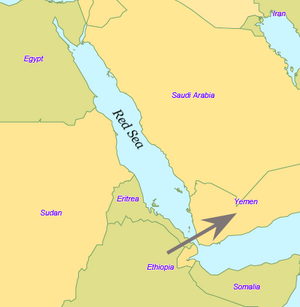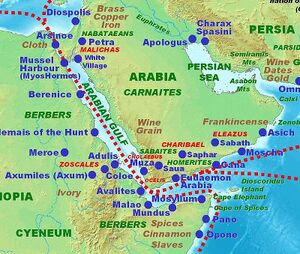Barbara
| Author:Laxman Burdak, IFS (R) |


Barbara (बर्बर) refers to two ancient regions in littoral Northeast Africa. The two areas were inhabited by the Eastern Barbaroi or Baribah ("Berbers" or Barbarians) as referred to by ancient Greek philosophers.
Origin
Variants
- Barbara बर्बर (AS, p.611)
- Barbarian
- Barbaras
- Barbaria
- Barbaroi
- Baribah
- Berber
- Varvara (वर्वर)
- Varbara (वर्बर) Mahabharata (3-255-18a)
Jat clans
Mention by Panini
V. S. Agrawala[1] writes that Gaṇa-pāṭha of Panini refers to janapada Barbara (बर्बर) (IV.3.93), on the sea cost near the mouth of Indus where the port of Barbarika was situated. (p.62)
Barbar (बर्बर) (also Parvata), Barbad (बर्बड़) is name of a Country mentioned by Panini in Ashtadhyayi under Dhumadi (धूमादि) (4.2.127) group.[2]
Barbar (बर्बर) is mentioned by Panini in Ashtadhyayi under Takshashiladi (तक्षशिलादि) (4.3.93) group.[3]
Barbara (बर्बर)/ Varvara (वर्वर) is name of a place mentioned by Panini in Ashtadhyayi under Krishashvadi (कृशाश्वादि) (4.2.80.2) group. [4]
Barbara (बर्बर) is mentioned by Panini in Ashtadhyayi. [5]
History
These inhabitants were the ancestors of today's local Afroasiatic-speaking populations such as Sudanese , Somalis and Bejas. However it has come to the surface, according to hieroglyphics that this name Barbaria could have an older origin with the Ancient Egyptian[6][7][8][9]
Geographers historically divided the eastern coast of Africa at large into several regions based on each region's respective inhabitants. In Somalia was Barbara, which was the land of the Eastern Baribah or Barbaroi (Berbers), as the ancestors of the Somalis were referred to by medieval Arab and ancient Greek geographers, respectively.[10][11][12]
In modern-day Eritrea and Ethiopia was al-Habash or Abyssinia,[13] which was inhabited by the Habash or Abyssinians, who were the forebears of the Habesha.[14]
According to the Periplus of the Erythraean Sea, a 1st-century CE travelogue written by a Greek merchant based in Alexandria, the first Barbara region extended from just south of Berenice Troglodytae in southeastern Egypt to just north of Ptolemais Theron in northeastern Sudan, whilst the second Barbara region was then located just beyond the Bab al-Mandeb up to the "Market and Cape of Spices, an abrupt promontory, at the very end of the Berber coast toward the east" found in northeastern Somalia. This second Barbara region was home to entrepôts known as the "far-side" ports.[15] Archaeological excavations led by Neville Chittick have identified the Market and Cape of Spices as the present-day Damo.[16]
Along with the neighboring Habash (Abyssinians) of Al-Habash toward the interior, the Periplus records the Berbers of the second Barbara region as engaging in extensive commercial exchanges with Egypt and Pre-Islamic Arabia. The travelogue mentions these Berbers as trading frankincense, among various other commodities, through their port cities such as Malao, Avalites, Mundus, Mosylon and Opone. Competent seamen, the Periplus' author also indicates that they sailed throughout the Red Sea and Gulf of Aden for trade. The document describes the Berbers' system of governance as decentralized, and essentially consisting of a collection of autonomous city-states.[17][18]
Jat History
Bhim Singh Dahiya[19] mentions about Jat clan- Babbar - Their Sanskritised name is Barbara. Arthashastra mentions a river named Srautasi on Barbara Kool.[20] बर्बरकूले समुद्रैकदेशे श्रीघंतो नाम हृद: As the name suggests, they were near the sea (Caspian? Aral ?). Their country was known to the Greeks, as Barbikae.
Sandhya Jain[21] mention Barbara (बर्बर) in the list of Tribes With unclear Position in Kurukshetra War as a northern Himalayan tribe (uttarajtha janmarah) (XII.200.40). Babbar (बब्बर) Jat Gotra found in Punjab when Sanskritised is Barbara.
In Mahabharata
Barbara (बर्बर) is mentioned in Mahabharata (II.29.15), (III.48.19),(VI.10.55), (XII.200.40)
Varbara (वर्बर) Mahabharata (3-255-18a)
Sabha Parva, Mahabharata/Book II Chapter 29 mentions the Countries subjugated by Nakula in West. Barbara (बर्बर) is mentioned in Mahabharata (II.29.15).[22]....And the son of Pandu (Nakula) then reduced to subjection the fierce Mlechchas residing on the sea coast, as also the wild tribes of the Pahlavas, the Barbaras,....
Vana Parva, Mahabharata/Book III Chapter 48 describes Rajasuya sacrifice of Yudhisthira attended by the chiefs of many islands and countries. Barbara (बर्बर) is mentioned in Mahabharata (III.48.19).[23]....and the chiefs of many islands and countries on the sea-board as also of frontier states, including the rulers of the Sinhalas, the Barbaras, the Mlecchas, .....
Karna's conquests: Vana Parva, Mahabharata/Book III Chapter 255 describes Karna's victory march and countries subjugated. Varbara (वर्बर) is mentioned in Mahabharata (3-255-18a).[24].... And, having come to the quarter of Varuna (वारुण) (3-255-18a), he made all the Yavana (यवन) (3-255-18a) and Varbara (वर्बर) (3-255-18a) kings pay tribute.
Bhisma Parva, Mahabharata/Book VI Chapter 10 describes geography and provinces of Bharatavarsha. Barbara (बर्बर) is mentioned in Mahabharata (VI.10.55). [25]....the Kachchhas, the Gopalakachchhas, and Langala, the Paravallaka, the Kiratas, the Barbaras, the Siddhas, the Vaidehas, and the Tamralingakas; ....
Shanti Parva Mahabharata Book XII Chapter 200 mentions Barbara (बर्बर) in verse (XII.200.40).[26]
Military Campaign of Karna: Mahabharata, Book 3, Chapter 252....And, having come to the quarter of Varuna, he made all the Yavana and Varvara kings pay tribute.[27]
बर्बर
विजयेन्द्र कुमार माथुर[28] ने लेख किया है .....1. बर्बर (p.611): बर्बर का उल्लेख महाभारत, वनपर्व में हुआ है- ‘वारुणीं दिशामागम्य यवनान् बर्बरांस्तवा, नृपान् पश्चिमभूमिस्थान् दापयामास वै करान्’ --महाभारत, वनपर्व 254, 18. अर्थात् कर्ण ने तब पश्चिम दिशा में जाकर यवन तथा बर्बर राजाओं को, जो पश्चिम देश के निवासी थे, परास्त करके उनसे कर ग्रहण किया। प्राचीन काल में अफ़्रीका के 'बार्बरी' प्रदेश के रहने वाले 'बारबेरियन' कहलाते थे तथा इनकी आदिम रहन-सहन की अवस्था के कारण इन्हें यूरोपीय (ग्रीक) असभ्य समझते थे, जिससे 'बाबेरियन' शब्द ही 'असभ्य' का पर्याय हो गया। महाभारत के उपर्युक्त उद्धरण में 'बार्बरी' या वहाँ के निवासियों का निर्देश है अथवा भारत के पश्चिमोत्तर भू-भाग या वहाँ बसे हुए सिथियन अथवा अनार्य जातीय लोगों का।
महाभारत के युद्ध की कथा में जिस धनुर्विद बर्बरीक का वृत्तांत है, वह संभवत: बर्बरदेशीय ही था।
2. बर्बर (p.611): बर्बर, काठियावाड़ या सौराष्ट्र (गुजरात) में सोरठ और गुहिलवाड़ के मध्य में स्थित प्रदेश था, जिसे अब 'बाबरियाबाड़' कहते हैं। संभवत: विदेशी अनार्य जातीय बर्बरों के इस प्रदेश में बस जाने से ही इसे बर्बर कहा जाने लगा था। इसी इलाके में 'बर्बर शेर' या 'केसरी सिंह' पाया जाता है।
External links
See also
References
- ↑ V. S. Agrawala: India as Known to Panini, 1953, p.62
- ↑ V. S. Agrawala: India as Known to Panini, 1953, p.509
- ↑ V. S. Agrawala: India as Known to Panini, 1953, p.511
- ↑ V. S. Agrawala: India as Known to Panini, 1953, p.503
- ↑ V. S. Agrawala: India as Known to Panini, 1953, p.62
- ↑ Huntingford, George Wynn Brereton (1980). The Periplus of the Erythraean Sea, Volume 2, Part 4, Issue 151. Ashgate Publishing, Ltd. pp. 59, 83 & 146. ISBN 0904180050.
- ↑ Raunig, Walter (2005). Afrikas Horn: Akten der Ersten Internationalen Littmann-Konferenz 2. bis 5. Mai 2002 in München. Otto Harrassowitz Verlag. p. 130. ISBN 3-447-05175-2.
- ↑ F.R.C. Bagley et al., The Last Great Muslim Empires, (Brill: 1997), p.174
- ↑ James Hastings, Encyclopedia of Religion and Ethics Part 12: V. 12, (Kessinger Publishing, LLC: 2003), p.490
- ↑ F. R. C. Bagley et al., The Last Great Muslim Empires (Brill: 1997), p. 174.
- ↑ Mohamed Diriye Abdullahi, Culture and Customs of Somalia, (Greenwood Press: 2001), p. 13.
- ↑ James Hastings, Encyclopedia of Religion and Ethics Part 12: V. 12 (Kessinger Publishing, LLC: 2003), p. 490.
- ↑ Sven Rubenson, The Survival of Ethiopian Independence (Tsehai, 2003), p. 30.
- ↑ Jonah Blank, Mullahs on the mainframe: Islam and modernity among the Daudi Bohras (University of Chicago Press, 2001), p. 163.
- ↑ Schoff, Wilfred Harvey (1912). The Periplus of the Erythraean Sea: Travel and Trade in the Indian Ocean by a Merchant of the First Century. London, Bombay & Calcutta.
- ↑ Chittick, Neville (1975). An Archaeological Reconnaissance of the Horn: The British-Somali Expedition. pp. 117–133.
- ↑ Schoff, Wilfred Harvey (1912). The Periplus of the Erythraean Sea: Travel and Trade in the Indian Ocean by a Merchant of the First Century. London, Bombay & Calcutta.
- ↑ Mohamed Diriye Abdullahi, Culture and Customs of Somalia, (Greenwood Press, 2001), pp.13-14
- ↑ Jats the Ancient Rulers (A clan study)/Jat Clan in India,p.245, s.n.5.
- ↑ Arthashastra, pt. p. 179 (Ganapathi Shastri edition).
- ↑ Sandhya Jain: Adi Deo Arya Devata - A Panoramic View of Tribal-Hindu Cultural Interface, Rupa & Co, 7/16, Ansari Road Daryaganj, New Delhi, 2004,p.137, s.n.142.]]
- ↑ ततः सागरकुक्षिस्दान मलेच्छान परमदारुणान, पह्लवान बर्बरांश चैव तान सर्वान अनयथ वशम (II.29.15)
- ↑ सागरानूपगांश चैव ये च पत्तनवासिनः, सिंहलान बर्बरान मलेच्छान ये च जाङ्गलवासिनः (III.48.19)
- ↑ वारुणीं दिशमागम्य यावनान्वर्बरांस्तथा (3-255-18a)
- ↑ कच्छा गॊपाल कच्छाश च लाङ्गलाः परवल्लकाः, किराता बर्बराः सिद्धा विदेहास ताम्रलिङ्गकाः (VI.10.55)
- ↑ उत्तरा पदजन्मानः कीर्तयिष्यामि तान अपि, यौन काम्बॊजगान्धाराः किराता बर्बरैः सह (XII.200.40)
- ↑ Parva Chapter 252
- ↑ Aitihasik Sthanavali by Vijayendra Kumar Mathur, p.611

